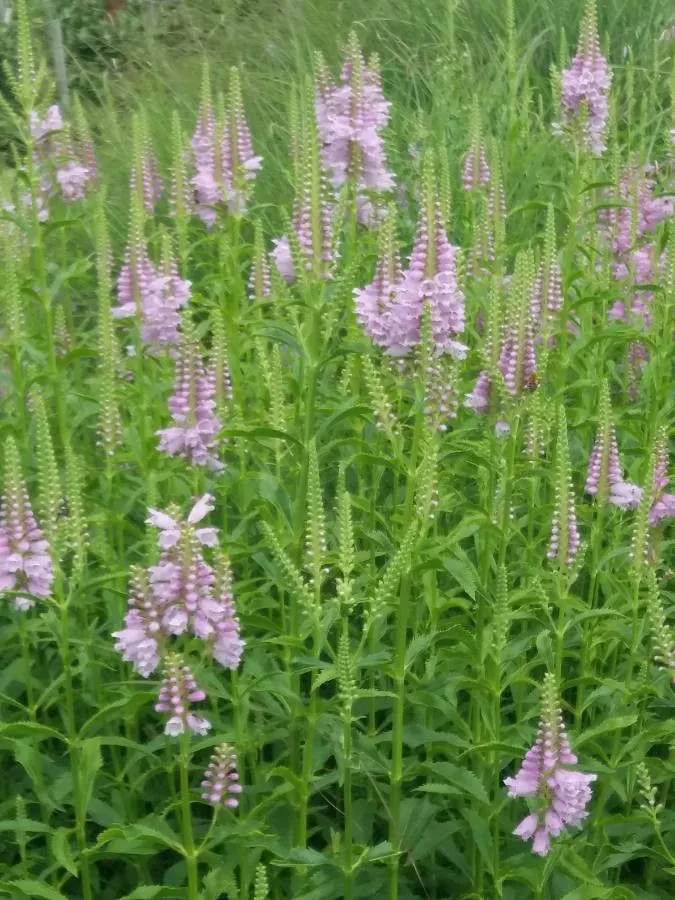
Author: (L.) Benth.
Bibliography: Edwards’s Bot. Reg. 15: t. 1289 (1829)
Year: 1829
Status: accepted
Rank: species
Genus: Physostegia
Vegetable: False
Observations: Canada to NE. Mexico
Obedience, known scientifically as Physostegia virginiana, is a striking and versatile perennial plant that belongs to the Lamiaceae family. This delightful species has been captivating the hearts of gardeners and botanists since its detailed description in Edwards’s Botanical Register in 1829 by the botanist L. Benth.
Native to a broad range of North America, Physostegia virginiana can be found flourishing from Canada all the way down to northeastern Mexico. Its adaptability across diverse climates and soil types underscores its robust nature and contributes to its popularity in landscaping projects.
The common name “Obedience” is derived from an unusual characteristic of the flowers’ ability to stay in place when repositioned. This feature makes it not only an interesting conversational piece but also useful in floral arrangements. The plant typically grows 2-4 feet high and produces dense, spiky clusters of tubular flowers that range in color from white to shades of pink and lavender. Blooming in late summer to early fall, these flowers are a magnet for bees, butterflies, and other pollinators, thereby playing a critical role in the ecosystem.
Obedience thrives best in full sun to partial shade and prefers moist, well-drained soils, although it can tolerate a variety of soil conditions. For gardeners, it offers minimal maintenance requirements while delivering maximal aesthetic appeal. It’s worth noting that the plant can spread quite aggressively under optimal conditions, so it should be monitored to maintain its growth within desired bounds.
Whether used in garden beds, borders, or as part of a wildflower meadow, Physostegia virginiana adds a unique charm and ecological value to any outdoor space. Its historical and botanical significance, coupled with its natural beauty, make it a cherished addition to many gardens and landscapes.
Dan: drejeblomst
Eng: false dragonhead, obedience, obedient plant, obedient-plant, virginia false dragonhead
Deu: gelenkblume
Swe: drakmynta
Hun: virginiai füzérajak
Nld: scharnierbloem
Fra: physostégie de virginie
Nob: virginialeddblom
Nno: virginialeddblom
En: Obedience, Obedient-plant, False dragonhead, Obedient plant, Virginia false dragonhead
Af: Skarnierblom
Az: Fizostegiya
Zh: 假龙头花
Cs: Řetězovka virginská
Da: Drejeblomst
Nl: Scharnierbloem
Fi: Kellopeippi
Fr: Physostégie de Virginie
De: Gelenkblume
Hu: Virginiai füzérajak
Nb: Virginialeddblom
Nn: Virginialeddblom
Pt-br: Falsa-cabeça-de-dragão
Sk: Fizostégia virgínska
Sv: Drakmynta
Zh-tw: 假龍頭花
Taken Sep 7, 2022 by Irmgard Groß (cc-by-sa)
Taken Sep 6, 2021 by Sabina Hartmann (cc-by-sa)
Taken Jul 31, 2021 by Jean Pierre (cc-by-sa)
Taken Sep 21, 2022 by Dieter Albrecht (cc-by-sa)
Taken Aug 14, 2021 by K Desvignes (cc-by-sa)
Taken Nov 15, 2020 by Kostadin Sokolov (cc-by-sa)
Taken Aug 30, 2021 by jeroen geise (cc-by-sa)
Taken Aug 30, 2017 by Gritti Andrea (cc-by-sa)
Taken Aug 2, 2020 by Wendy Kivit (cc-by-sa)
Taken Sep 11, 2017 by Dieter Wagner (cc-by-sa)
Taken Jul 12, 2019 by Brian (cc-by-sa)
Taken Aug 17, 2020 by Maria van der Sluis (cc-by-sa)
Taken Aug 14, 2021 by K Desvignes (cc-by-sa)
Taken Sep 21, 2022 by Dieter Albrecht (cc-by-sa)
Taken Oct 2, 2022 by Andrzej Konstantynowicz (cc-by-sa)
Taken Oct 15, 2021 by gysin pat (cc-by-sa)
Taken Nov 21, 2022 by Nathalie Potel (cc-by-sa)
Taken Nov 21, 2022 by Nathalie Potel (cc-by-sa)
Taken Nov 21, 2022 by Nathalie Potel (cc-by-sa)
Taken Nov 21, 2022 by Nathalie Potel (cc-by-sa)
Taken Jan 1, 1900 by EOL − Gerrit Davidse (cc-by-nc-sa)
Taken Sep 15, 2013 by Photoflora – Benoit BOCK (©)
Taken Sep 19, 2022 by Lindsey Cunningham (cc-by-sa)
Taken Nov 21, 2022 by Nathalie Potel (cc-by-sa)
Taken Nov 21, 2022 by Nathalie Potel (cc-by-sa)
© copyright of the Board of Trustees of the Royal Botanic Gardens, Kew.
© copyright of the Board of Trustees of the Royal Botanic Gardens, Kew.
Taken Sep 29, 2022 by Ani Strand (cc-by-sa)
Taken Sep 15, 2013 by Photoflora – Benoit BOCK (©)
Growth habit: Forb/herb
Family: Myrtaceae Author: (F.Muell.) K.D.Hill & L.A.S.Johnson Bibliography: Telopea 6: 402 (1995) Year: 1995 Status:…
Family: Rubiaceae Author: Pierre ex A.Froehner Bibliography: Notizbl. Bot. Gart. Berlin-Dahlem 1: 237 (1897) Year:…
Family: Sapindaceae Author: Koidz. Bibliography: J. Coll. Sci. Imp. Univ. Tokyo 32(1): 38 (1911) Year:…
Family: Asteraceae Author: A.Gray Bibliography: Pacif. Railr. Rep.: 107 (1857) Year: 1857 Status: accepted Rank:…
Family: Fabaceae Author: Medik. Bibliography: Vorles. Churpfälz. Phys.-Ökon. Ges. 2: 398 (1787) Year: 1787 Status:…
Family: Aspleniaceae Author: (Cav.) Alston Bibliography: Bull. Misc. Inform. Kew 1932: 309 (1932) Year: 1932…